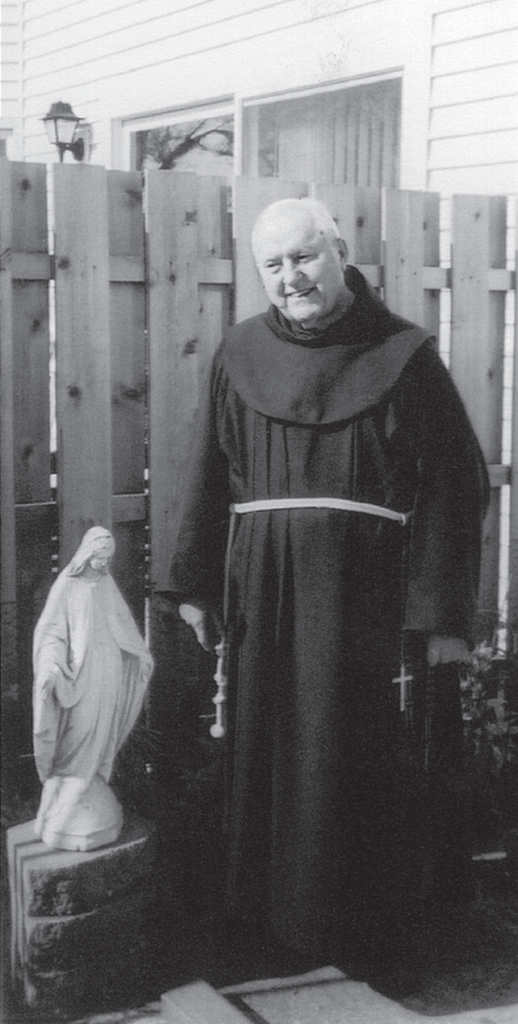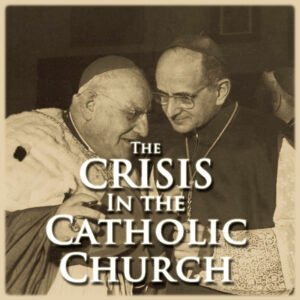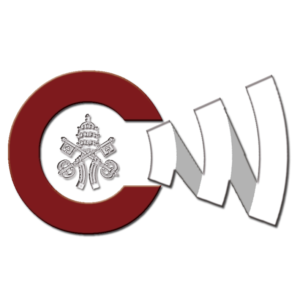(Fall, 2006)
Known as Frank Stepanich in his pre-Franciscan days, the future Father Martin was born on a farm near the small town of Neodesha in southeast Kansas on November 12, 1915. Grade school education at the nearby Brooks country school was followed by one year at Neodesha High School. Answering the call of God, he then enrolled at the preparatory minor seminary (called St. Joseph College at that time) of the Franciscan Fathers of the St. Louis-Chicago Sacred Heart Province near Westmont, Illinois, in the fall of 1930.
Four years later, Frank entered the Franciscan Order, receiving the Franciscan habit on September 2, 1934, at St. Mary’s Seminary and Monastery of the Slovene Franciscan Fathers, east of Lemont, Illinois. He chose the name Martin as his religious name in honor of St. Therese Martin, the Little Flower. The one-year novitiate was followed by temporary simple vows on September 3, 1935, and then he gave himself to God totally and forever with final solemn vows on September 3, 1938.

After the required courses of philosophy and theology, Friar Martin was ordained a priest of God by Chicago’s Bishop Sheil at the old Quigley Seminary in north Chicago on May 18, 1941. He offered his first solemn Mass in St. Ignatius Church in Neodesha, Kansas, where he had been baptized, received First Holy Communion, and confirmed.
After one more year of theology, Father Martin was sent to the Catholic University of America, Washington, D.C., for advanced studies in Sacred Theology. He received his degree of Doctor of Sacred Theology (S.T.D.) from the Catholic University in 1948. His first writing was his doctoral dissertation, entitled “The Christology of Zeno of Verona.” Later on, in 1960, he began writing many articles for such Catholic publications as The Marylike Crusader, The Wanderer (in its better days), The Remnant (in its earlier years), and others. In the post-Vatican II years, he has written much on such topics as the error of Feeneyism, the correct understanding of sedevacantism, and the validity of the Thuc episcopal consecrations.

Returning to St. Mary’s Seminary, Lemont, Illinois, Father taught theology to a handful of seminarians for two years, only to be then obliged to take over as editor of the Slovene language Ave Maria monthly magazine for five years.
Taking up teaching once again, Father Martin taught religion for two years at the College of St. Francis (for young women) in Joliet, Illinois. That was followed by two years of teaching religion at the neighboring Mount Assisi Academy (for girls). He then did his last academic teaching of religion with a small class of novices at the Mount Assisi Convent for two more years. By then, the creeping modernist revolution that was to generate Vatican II had already begun its undercover infiltration into the minds and hearts of Catholics. Pope Pius XII duly complained that people had “lost the sense of sin,” and in his encyclical Humani Generis, he warned of the so-called “new theology” that was making headway in Catholic institutions.
All during his early priestly years, Father Martin was regularly sent to various parish churches for both weekday and Sunday Mass, as were also the other Fathers of St. Mary’s, as well as for preaching and hearing confessions. But he never served as a parish priest for any extended length of time. It is well to note that Father Martin was librarian for the comparatively small St. Mary’s Library for over thirty years. But when the Vatican II un-Catholic revolution got underway, he was “relieved” of his library position because he failed to purchase for St. Mary’s Library those supposedly “wonderful” new modernist books that began flooding the Catholic world. For refusing to purchase such books, he was accused of “disobeying the bishops and the Council and the Pope.”
The Council years of the 1960’s were bewildering and frustrating years for Father Martin, just as they were for so many other genuinely traditional Catholic priests and religious and lay people. He could plainly see that there was a drastic departure from the traditional Catholic Faith, discipline and practice in the making, and he could not in conscience go along with it.
The crucial and decisive issue that kept Father Martin firm in the traditional and unchangeable Catholic Faith, and true to the one, holy, Catholic, and apostolic Church, turned out to be the traditional Latin Holy Sacrifice of the Mass as restored by Pope St. Pius V in 1570, on orders of the holy Council of Trent.
The year of decision for Father Martin was 1967, two years after the close of the modernist Vatican II Council. Father was in Ireland in October of 1967, taking part in a never-to-be forgotten inspiring pilgrimage to some of Europe’s holiest shrines. A Dublin paper reported that the American bishops planned to “jump the gun” and introduce the all-English Canon of the Mass well before the time assigned by Rome.
On his return to the U.S., Father Martin was sent to St. Patrick’s Church in Lemont for a weekday Mass, in which he was expected to use the all-English canon, and out loud at that. But Father used only the traditional all-Latin Canon, and he was bold enough even to sing the Latin Pater noster.
The Dominican superioress of St. Patrick’s Convent reported Father Martin to his religious superior (called “Father Guardian”), and, sure enough, Father was “called on the carpet.” “Why don’t you go along with the changes?” he heard Father Guardian cry out menacingly at him. Father Martin could in no way be persuaded to give up the traditional and unchanged Catholic Latin Mass.
From then on, Father Martin was allowed to offer Mass only privately, and that was either in the privacy of the monastery chapel or in a vacant classroom upstairs. This went on for about two years or so. Father Martin never touched what he calls the Novus Ordo “performance” — that is, the Novus Ordo Missae of Paul 6 — when it showed up in 1969.
One cool autumn day, during that uncomfortable time, a gentleman named Guido Del Rose, highly-regarded promoter of the Fatima Pilgrim Virgin, suddenly came up to the unsuspecting Father Martin as he was pruning red pine tree branches behind St. Mary’s Lourdes Grotto. Guido requested Father to conduct monthly allnight vigils in St. Mary’s Nativity Church in Joliet. Father agreed to do so, and he did it for about two years or so. Father preached two sermons each night, always intent on strictly Catholic doctrine, unmixed with any modernist Vatican II fallacies. Many of those sermons still exist on cassette tape.
Then, one not-so-fine day, Father Martin was suddenly commanded by his superior, “Find your own place for Mass! And we will not provide transportation for you!”

Not knowing exactly where to go for his daily Mass, Father Martin was directed by an acquaintance to St. Nicholas Convent on Chicago’s far south State Street. There he met the two Rowley sisters, Sister Yvonne and Sister Olive, members of the School Sisters of St. Francis of Milwaukee (at one time the top-rated Sisters’ congregation in the U.S.). The two Sisters eagerly accepted Father’s offer to have the traditional Latin Mass in their chapel every day. At the time, the Sisters were wearing the so-called “modified,” or abbreviated habit and veil, but they definitely returned to the traditional full-length habit and veil of the order on March 29, 1970.

Father Martin had no car of his own, so the Sisters came some 20 miles to St. Mary’s, Lemont, in their not-the-best convent car every evening to bring Father to St. Nicholas, then take him back to Lemont the next morning after Mass and breakfast. And, for the monthly all-night vigils in Joliet, the Sisters would come and pick up Father at St. Mary’s and then the three would go on another 15-20 miles to Joliet for the vigils. Eventually the Sisters managed somehow, with the help of benefactors, to get Father a car for him to use for all his travels. From then on, thanks to God, Father has always had a car at his disposal.
After a couple of years or so, the disturbing news came around that Cardinal Cody was going to close and sell St. Nicholas Church, together with the convent. And now began a long series of “flights” of Father Martin and the Sisters from one “catacomb” place to another, where the true Catholic Mass could be offered. The exact length of time at each “catacomb” cannot be given accurately, but the “flights” of Father and the Sisters went on for about 12 years or so. And none of this could have gone on without God inspiring benefactors to provide generous financial help, as well as plenty of other kinds of favors.
From St. Nicholas Convent, Father and the Sisters “fled” down to the vacant St. Liborius Convent in Steger, south of Chicago, but in the Joliet diocese. Steger was 34 miles from Lemont, so Father Martin traveled those 34 miles to Steger every evening in some of the worst kinds of weather, and then returned to Lemont every morning. Bishop Blanchette of Joliet learned that Father Martin was offering the traditional Latin Mass in his diocese, so he promptly ordered him out of Steger.
Father and the Sisters left Steger in the overloaded old cars on a Sunday (Mothers’ Day), and worked their way northward through Chicago’s busy streets until they came to west suburban Berwyn. There they settled down in the home of Frank Rowley, older brother of the two Sisters. Father offered the true Latin Mass in the basement of Frank’s home in a tiny room.
After a time, some friends made it possible for Father and the Sisters to move, on July 3, 1975, to an old mansion in suburban Evergreen Park on Longwood Drive near 5th Street. They called it the “Longwood House.” Raccoons had fun playing around in the attic of the house. Father offered Mass in a small room above the back porch. After a year or so, a McCarthy fellow bought the mansion, so Father and the Sisters had to go.
Due to betrayal by “friends,” they moved, in desperation, to an old farmhouse in Homer Township, some miles east of Lemont, a bit east of Bell Road. No need to go into details about the house, except to say that there were plenty of cats at the place, including a young playful one that the Sisters named “Junior.” And hornets were high above the back porch, and not inside the house.
The owners of the farmhouse eventually demanded that Father and the Sisters must leave. They even busted their way into the house through the back door when Father and the Sisters were not home. Then one afternoon, a fellow named Bob Church delivered a propane gas tank at the farmhouse so that the Sisters could continue cooking meals. Sister Yvonne told Mr. Church that they were ordered to leave the place but had no place to go. He told Sister that he had a house available in Posen, nearer to Chicago, and that they could have it immediately. So that’s where Father and the Sisters went next, in order to keep the true Mass going every day.
It wasn’t too long after that Father and the Sisters were obliged to look for another place for the exiled true Mass. And, once again, Frank Rowley let them come to his Berwyn home for a second brief stay. Father Stanley Wasylik heard of their plight, and he generously invited them to come to his Christ the King Shrine near Winfield, west of Wheaton. They lived in the church basement and that is where Father offered daily Mass.
After about a year, someone made it possible for Father and the Sisters to move to what they called the “Saratoga House,” because it was on Saratoga Street, a few miles north of Lemont. In that house, Father’s sleeping quarters were in the basement, and so was the chapel. On a July 1 night, a 5-inch rainstorm brought 8 inches of water into the basement. Father had to carry the tabernacle up to the living room, where he offered Mass.

And then — Deo gratias! The final move came for Father Martin and the Sisters. After visiting very many available houses in different places with real estate agent Edie Baker, the Sisters came upon a house in Bolingbrook that seemed to them suitable. Father saw it and said it was satisfactory. A noble-hearted benefactor agreed to buy the house, with his main intention being to provide Father Martin with a permanent place in which he could offer the traditional Latin Mass — the Tridentine Mass, as it is called. Father and the Sisters moved into that Bolingbrook house on December 15, 1983. It was in that house that Father Martin offered his 65th anniversary Mass on May 18, 2006, with a small group of friends and relatives present. The benefactor mentioned remains the owner of the Bolingbrook house.
All through the more than 35 years of keeping the traditional Latin Mass alive in so many different places, the assistance of benefactors, by way of financial gifts and other favors, was — and still is — indispensable. But for many long years, in order to help the Sisters put enough food on the table, Father himself maintained, at St. Mary’s, a very large garden (40 feet by 150 feet), in which he grew quite a variety of vegetables, plus plenty of sweet corn and melons. He was able to store away enough potatoes and onions to last through the winter each year. Raccoons and ground hogs and squirrels and field mice thought the garden was a good idea.
Besides gardening, Father Martin also managed, in his spare time, to take care of what he calls “Our Lady’s Place” on St. Mary’s grounds — that is, sacred outdoor shrines that include the Lourdes grotto, the Fatima shrine, the outdoor Franciscan Rosary (or crown) of the Seven Joys of Mary, the Stations of the Cross, Bishop Frederick Baraga shrine, and the monastery cemetery. And one of his specialties since the days of his 1934-35 novitiate was taking care of flowers.
About the middle 1990’s, Father Martin found it advisable to retire from gardening and all other work at St. Mary’s. Today, (when this article was written) there is no trace of his once very visible garden. Yet Father still has enough energy, at near 91, to take care of Our Lady’s flowers at the Bolingbrook house. Lilies of all kinds and colors, both Asiatic and Oriental lilies, make a spectacular display in June and July. But they are supported by various other kinds of beautiful flowers. And Father is still able to drive a car.
The two Sisters, from their St. Nicholas days and all through the years, hoped and prayed that some Sister or other would join them in living the true religious life, but none ever came. It was heartbreaking for them.
Because of the Sisters’ singing talents, Father Martin was able to sing a Gregorian chant Mass almost every day of the year. But when Sister Yvonne’s health began to fail, he had to discontinue doing so, as well as to curtail a busy religious schedule. After several years of much suffering, Sister Yvonne was called into eternity by the Most High on December 15, 2002.
Sister Olive, no longer in the best of health at 86, continues courageously, but she has — Deo gratias! — the very able help of Samantha, an excellent young Michigan farm woman.
Father Martin, realizing that “the night shades of life may soon be falling,” dreams of the day when God will mercifully allow him to help St. Therese, the Little Flower, with her heavenly “shower of roses.”
Father Martin Stepanich, 97, passed away November 18, 2012, at 9:30 p.m.
–Taken from the Reign of Mary Quarterly Magazine, Issue 124


One Response
I know him well. We repeated vows together in his last Years.